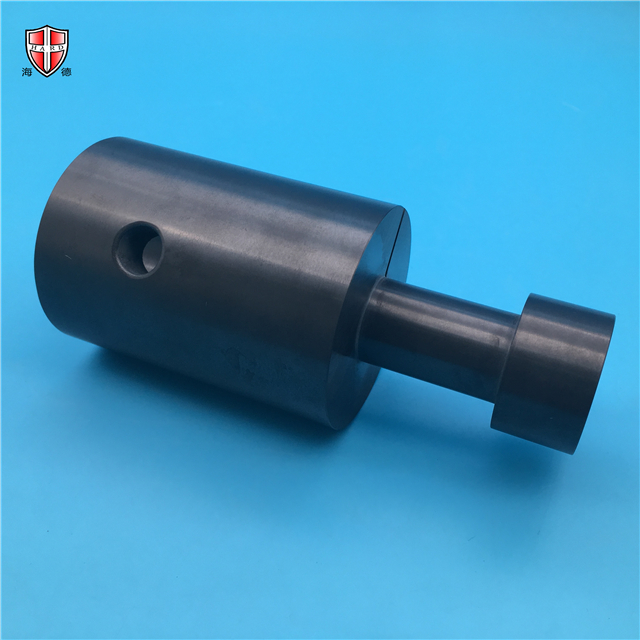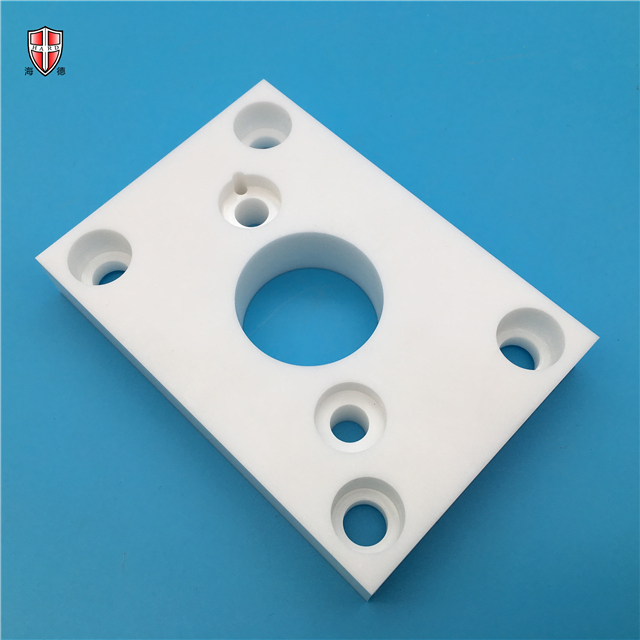Ceramic materials have high brittleness, high hardness, and are prone to defects during processing, and three-dimensional network ceramic / metal composite materials have greater requirements for the construction of ceramic skeletons, requiring a large number of holes in the ceramic skeleton, which are connected in three dimensions in space, resulting in The forming process is far more complicated than ordinary ceramics. The current organic ceramic precursor impregnation process, sol-gel process, foaming process, particle stacking process, adding pore-forming agent process and other network ceramic preparation processes have unfavorable factors such as complex process, large difficulty, long cycle and high cost, which hinders Large-scale industrial application of ceramic / metal composite materials. Therefore, how to develop a suitable ceramic skeleton structure and related preparation processes according to the performance requirements of the material is the focus of the research on three-dimensional network ceramic / metal composite materials.

Compared with traditional manufacturing technology, 3D printing technology has a faster manufacturing speed and can directly produce parts of any complex shape. It is a manufacturing technology with promising application prospects and in line with future technological development trends. It has attracted the attention of many scholars at home and abroad. . At present, 3D printing technology has been well applied and developed in the field of polymers and metal materials, and has also made some technological breakthroughs in the field of ceramic materials. In the mid-1990s, researchers began to try to mold ceramic parts through 3D printing technology, and have made significant research progress.
3D printing technology has great advantages in manufacturing ceramic skeletons (network structure, porous structure) of ceramic / metal composite materials. 3D printing technology does not rely on complex molds and mechanical processing, and can develop different structures according to different performance requirements of materials The ceramic skeleton, which will make a huge change in the field of ceramic / metal composite materials. At present, there are dozens of commercial 3D printing technologies. The more common 3D printing molding processes of ceramic components include: fused deposition ceramic molding, laser sintering of laser sintered coated ceramic powder, and UV curing photosensitive resin-based ceramics. Three-dimensional photolithographic molding of paste, three-dimensional printing molding of organic binder bonding ceramic powder, layered solid molding of hot-press bonding ceramic film material, inkjet printing molding technology and other processes. This article mainly describes the technical principles and characteristics of the 3D printing molding process of ceramic components, and reviews the key technologies involved.
2. Introduction of ceramic 3D printing technology
2.1 Fused deposition modeling technology
Fused deposition modeling technology (referred to as FDC) was developed from fused deposition modeling technology and was first developed by Argonne National Laboratory and Rutgers University. In this process, organic binder is mixed with ceramic powder, and after being made into silk by capillary rheometer or extruder, under the control of the computer, the composite filament is melted at a temperature slightly higher than its melting point to obtain ceramic After removing the polymer binder in the green body through degreasing treatment for the green body, the ceramic fired parts are obtained under suitable high temperature conditions. The materials suitable for the FDC process must have certain thermal and mechanical properties. Strength, bonding performance, viscosity, and elastic modulus are the four elements that measure the process material.
In 1996, Agrarwala of the American Ceramic Research Center used the FDC process to manufacture Si3N4 parts for the first time. The relative density of the formed Si3N4 green body was 53%. The ceramic body made contains more polymer binder, which was degreased twice After that, the density of the sintered Si3N4 parts reached 98%, and the flexural strength was (824 ± 110) MPa. Compared with the isostatic pressing process, the Si3N4 green body produced by fused deposition molding technology has anisotropy, and the linear shrinkage rate is 16.6% ± 1.3% in the X and Y directions, and in the Z direction It is 19.3% ± 1.6%, but the sintered density and strength are not much different.
Bandyopadhyay, etc. uses fused silica and polypropylene (polypropylene) -based thermoplastic binders to mix, and uses fused deposition to form fused silica ceramic preforms. After degreasing and sintering the ceramic blanks, pressureless infiltration is used. Methods The molten Al melt was impregnated into the ceramic preform at 1150 ° C to manufacture Al2O3-SiO2-Al ceramic / metal composite materials. The compressive strength of the composite materials reached (689 ± 95) MPa. The disadvantage of fused deposition modeling technology is that the lamination of tiny structural parts is not accurate enough, and the ceramic body made is difficult to remove due to the binder, which leads to defects such as bubbling, deformation and cracking during subsequent sintering.
2.2 Selected area laser sintering technology
Laser selection sintering molding (referred to as SLS) technology was first proposed by Deckard of the University of Texas at Austin in 1986, and 3Dsystems in the United States and EOS in Germany subsequently developed a molding system based on SLS technology. SLS technology uses the powder accumulated on the platform as a raw material, and uses a computer-controlled laser beam to scan the powder in a specific area, so that the powder is heated, melted, and solidified. After scanning, a new layer of powder is added, and then the above steps are continued to be repeated, layer by layer. Finally, a three-dimensional article is formed. For plastic products, the laser can completely melt the polymer powder to obtain the final molded part. The sintering temperature of ceramic materials is very high, and it is difficult to sinter directly with laser. Usually, people coat the refractory ceramic powder with a polymer binder, and adhere the layers by laser melting binder to obtain a ceramic green body. Then use degreasing to remove the binder and sinter, and finally get the ceramic parts.

In 1995, Subramanian of the United States took the lead in preparing ceramic parts using SLS technology. He added a polymer binder of 20% to 40% by volume to the alumina powder to perform SLS molding on the mixed powder. The green body was subjected to low temperature After the treatment removes the binder, high-temperature sintering is performed at 1600 ° C to obtain an alumina ceramic with a relative density of 50% and a bending strength of 8 MPa. British TobyGill et al. Mixed nylon powder and SiC powder at a volume ratio of 1: 1 to obtain SiC parts with a porosity exceeding 45% and a tensile strength of 5 MPa.
Shahzad et al. Used polymer-coated Al2O3 powder to perform SLS molding of the ceramic body. The density of the ceramic body obtained was 29% to 34% of the theoretical density. High temperature sintering was performed to obtain Al2O3 ceramic with a relative density of 39%. In order to obtain densified sintering, Shahzad subjected the green body to hot isostatic pressing at 135 ° C and 64 MPa for 5 minutes to increase the green body density to 83%. 88%, the bending strength is (148 ± 22) MPa, and the volume shrinkage of Al2O3 ceramics after sintering is 62%. JanWilkes et al. Directly used laser melting to manufacture fully dense ceramic parts (Figure 2). The ZrO2 / Al2O3 mixed powder was melted at 1600 ° C by a focused laser beam. The ceramic parts were directly molded without any sintering or post-treatment process. Dense, no cracks occur, and the bending strength exceeds 500MPa.
2.3 Stereolithography technology
Stereolithography (abbreviated as SLA) technology is a technology that uses ultraviolet light to cure a liquid resin material that is very sensitive to ultraviolet light. It was first proposed by Charles Hull in 1984, and then 3DSystems turned its ideas into reality and realized SLA. Commercialization of technology. SLA was initially used for the molding of polymer materials, and then only for the molding of ceramic materials. When preparing ceramic parts, firstly mix the ceramic powder with the photocurable resin uniformly to obtain a ceramic slurry with high solid phase content and low viscosity, and then control the ultraviolet light to selectively irradiate the surface of the slurry, so that the slurry containing the ceramic powder is photopolymerized , To form a ceramic body combined with a polymer aggregate, and then through degreasing and sintering to obtain the required ceramic parts.

In 1996, Griffith et al. Used SLA technology to manufacture ceramic parts for the first time. They used SiO2, Al2O3 and Si3N4 ceramic powder and photosensitive resin to mix them uniformly to obtain a slurry with a solid phase content of 40% to 55%. The ceramic body is molded in the same way. After degreasing at 600 ℃, the alumina ceramic is sintered at 1550 ℃ to obtain a ceramic with a density close to the theoretical density, an average grain size of about 1.5μm, and an interlayer interface. Hinzewski et al. Studied the effects of dispersants and diluents on the rheology of ceramic-photocurable resin slurries, and obtained a slurry with a solid phase content of 53%. The relative density of alumina ceramic parts after sintering was 90.5%.
Shandong Industrial Ceramics Research and Design Institute adjusts the ratio of light-curing resin, dispersant, anti-settling agent, and quartz powder to obtain ceramic slurry with a solid phase content of up to 70vol%, and then prints out the quartz ceramic green body by light curing molding. After sintering at 1200 ℃, the density of quartz ceramic parts is 1.65g / cm3 (Figure 3), and the compressive strength reaches 20MPa. In terms of commercial applications, Austrian Lithoz has developed photolithography-based ceramic manufacturing technology and manufactured the first printable high-precision, high-purity ceramic parts. Dimensional printer-CeraFab7500, which can print high-purity alumina and zirconia ceramic parts with four-point bending strength of 430MPa and 650MPa respectively.
2.4 3D printing technology
Three-dimensional printing (referred to as 3DP) technology is a manufacturing method using droplet ejection technology, mainly developed by the Massachusetts Institute of Technology and Soligen Corporation. According to the information output by the computer, 3DP technology sprays the adhesive through the print head to pile up the powder layer by layer into the final product. This technology can be used to mold ceramics, metals, ceramic / metal composites and polymer materials. The binders used are silica sol, polymer binders, etc.

The ceramic blanks formed by 3DP technology are bound together by loose powder. The density is relatively low and it is difficult to sinter directly. Generally, the post-treatment process is used to make it dense and sintered. In 1993, Yoo et al. First used the 3DP method to mold ceramic bodies. The relative density of the ceramic bodies after molding was only 33% to 36%. By isostatically pressing the ceramic bodies, the density reached 99.2% The alumina ceramic parts have a bending strength of 324MPa. Weng Zuohai et al. Prepared porous silicon nitride ceramics using silicon powder as the raw material and dextrin as the binder. This process first prepared the porous silicon green body using 3DP technology, and then obtained a porosity of up to 74% after sintering treatment 2. The porous silicon nitride ceramic with a bending strength of 5.1MPa has a linear shrinkage rate of less than 2% after sintering.
Teng et al. Of the Massachusetts Institute of Technology used 3DP technology to prepare ZTA ceramic parts. By selectively adding ZrO2 particles to the Al2O3 substrate, a sample with a gradient of composition was obtained. The flexural strength of t-ZTA ceramic after sintering was 670MPa. The fracture toughness is 4MPa · m1 / 2, and the performance of ceramic parts is similar to that of ZTA ceramics made by traditional methods. W. The porosity of Ti3SiC2 ceramic parts prepared by Sun and others using 3DP technology is as high as 50% to 60%, but combined with cold isostatic pressing and sintering process, Ti3SiC2 ceramic parts with a relative density of 99% can be obtained. NahumTravitzky et al. Used alumina as raw material and dextrin as binder to prepare porous alumina preforms using 3DP technology (Figure 4). The porosity of the ceramic can be controlled by adjusting the solid phase content of the slurry. When the content is 33vol% ~ 44vol%, the bending strength of the molded body is in the range of 4 ~ 55MPa, the shrinkage of the alumina ceramic after 1600 sintering is 17%, by immersing the green body and Cu-O alloy after sintering at 1300 ℃ Infiltration treatment, the fracture toughness of the composite material can reach (5.5 ± 0.3) MPa · m1 / 2, and the bending strength is (236 ± 32) MPa.
2.5 Layered solid forming technology
Layered entity molding (LOM for short) technology is developed and commercialized by LonePeak Engineering and Helisys in the United States. This process uses lasers or knives to cut plastic film, thin paper, metal sheet or ceramic sheet and other sheets, layer by layer through hot pressing or adhesive heating, and superimpose to obtain three-dimensional solid parts. In 1994, Griffin and others of LonePeak Company first used LOM technology to manufacture Al2O3 ceramic parts, and obtained ceramic parts with high flexural strength of about 311MPa, which is similar to the flexural strength (325MPa) of ceramic parts obtained by dry press molding.
Griffin also studied the LOM technology of ZrO2 / Al2O3 composite materials. After sintering, composite materials with strength of 570 ~ 688MPa and fracture toughness of about 10MPa · m1 / 2 were obtained. Zhang et al. Used Al2O3 and polymer binder to make LOM ceramic flakes. After removing the binder at 240 ℃, sintering at 1580 ℃ gave a porosity of 2.9% and a bending strength of 228MPa Ceramic pieces. Klosterman et al. Used bimodal silicon carbide powder, carbon black and graphite powder mixed with a polymer binder system to make ceramic flakes, using LOM technology to manufacture SiC ceramic parts (Figure 5), and discussed the interface problems between SiC ceramics. A ceramic part with a four-point bending strength of (169 ± 43) MPa was obtained.
2.6 Inkjet printing technology
Inkjet printing molding (referred to as IJP) technology is developed from the three-dimensional printing molding technology, which mixes ceramic powder with various organic substances and solvents into ceramic ink, and sprays the ceramic ink layer by layer on the platform through computer instructions To form a ceramic body of the desired shape and size. The preparation of ceramic ink is the key to inkjet printing technology, which requires ceramic powder to have a good uniform dispersion in the ink, suitable surface tension, viscosity and electrical conductivity, faster drying rate and higher solid phase content. The low solid content of ceramic ink is a major problem of IJP technology. The solid content of ceramic ink is usually only 5%.
Both Bruno University in the United Kingdom and Tianjin University in China have conducted in-depth research in this area, increasing the solid content of ceramic ink from the initial 3vol% to 15vol%. Seerden et al. Used paraffin as a medium to add to the alumina powder, the solid content of the ink can reach 20% by volume, and a denser sintered body was obtained, but there were problems such as too high viscosity and difficulty in spraying. Cappi et al. Used IJP technology to produce silicon nitride ceramic gear blanks with a density of 3.18g / cm3, a compressive strength of 600MPa, and a fracture toughness of 4.4MPa · m1 / 2. The performance of ceramics produced by traditional dry molding is comparable. Cornell University Larson et al. Found that by adjusting the ratio of SiC colloid and polyborosiloxane mixed ink, the density of the silicon carbide structure can be adjusted. The mixed ink can be converted into silicon carbide ceramic parts after sintering at 1800 ℃ (Figure 6). When the relative density is 48.9%, the bending strength reaches 70.4MPa.
Outlook
The emergence of 3D printing technology has subverted the traditional manufacturing model, and has great potential in complex structures, integrated manufacturing, reducing costs and shortening the development cycle. It has aroused widespread attention and attention worldwide. At present, a variety of 3D printing molding processes suitable for ceramic parts have been developed, such as fused deposition ceramic molding, laser selective sintering molding of laser sintered coated ceramic powder, three-dimensional lithography molding of UV-curable photosensitive resin-based ceramic paste, and hot press bonding Processes such as layered solid molding of ceramic film materials, three-dimensional printing molding of organic binder bonded ceramic powder, inkjet printing molding technology, etc., and great progress has been made in material molding. However, there are still many deficiencies that need to be perfected. The performance and density of the molding materials are not ideal. Usually, a cumbersome post-treatment process is required to improve the density of the ceramic parts. The accuracy and quality of the ceramic parts cannot meet the actual needs. There is still a certain distance to achieve large-scale industrialization and engineering application. In the future, it is necessary to continue to improve the accuracy, efficiency and speed of 3D printing, to develop multi-material, large-size object printing process methods, to improve the mechanical, surface quality and physical properties of ceramic parts, so as to achieve direct product-oriented manufacturing.
Author: Li Ling, Gao Yong, Wang Zhong-Hai, Wang Hongsheng, LITERATURE, Zhao Bo, Song Tao, Wang camp, Ding Shen Liang (Shandong Industrial Ceramics Research Institute Co., Ltd.)
